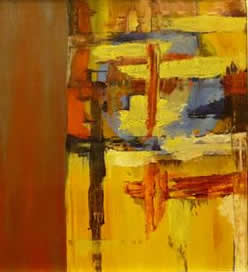 as well as an SOS grant. I also had a joint appointment at Lehigh University in the Art and Psychology Departments.
as well as an SOS grant. I also had a joint appointment at Lehigh University in the Art and Psychology Departments.Neural Art
PART 1 – THE BEGINNINGS
This is a brief description of the development of one of the areas that I have pursued in my art work, what I have called Neural Art. While I have created two and three dimensional works other than Neural Art, it has remained a major influence on my work. Many of these works are described elsewhere on the web site. .
I have had two careers. One was in Cognitive Neuroscience with a Ph.D. from Brown University in experimental psychology, post doctoral training in neurophysiology, research grant support from the National Institutes of Health, full professor at Lehigh University, etc. The emphasis here was on the neurophysiological basis of vision and visual perception. My other career is in the visual arts. I completed the Foundation Program in studio art with an emphasis on painting and drawing at the Boston Museum School and also studied studio art at the University of Hawaii and the University of Rhode Island. Twice I have been awarded artist fellowships from the Pennsylvania Council on the Arts  as well as an SOS grant. I also had a joint appointment at Lehigh University in the Art and Psychology Departments.
as well as an SOS grant. I also had a joint appointment at Lehigh University in the Art and Psychology Departments.
Initially these careers were parallel. I was doing both and there was no overlap. However, during the 1970’s, I reached a point where in order to continue my basic research in the neurophysiology of vision I would need a major retooling of my experimental techniques. As a result I decided instead to try to merge my interest in neurophysiology of vision and perception with my art work. This opened up some intriguing possibilities and also made my life more integrated.
Some of my earliest attempts were based on the idea that since the perceptual nervous system is especially sensitive to lines and edges, there are limits on the aesthetic experience. Other special sensitivities, such as color, produce similar limitations. I published a short article developing these ideas (Shortess, 1974). One of the pieces, Edges 1 is illustrated here.
Since I have always tried to have my work be thoughtful rather than spectacular, I was drawn to the possibilities of conceptual art approaches. This seemed partic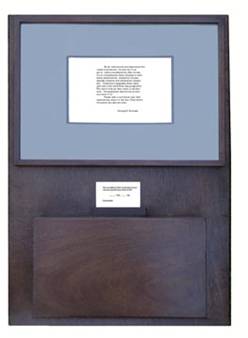
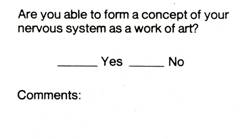 ularly appropriate as I looked at the possible relationships between art and neuroscience. This work was initially focused on thinking about the nervous system as a work of art. In one piece from 1979, I presented viewers with a wall panel that contained framed instructions, printed cards and a drop box with a slot in the top as shown here, with layout of the printed card. The text of the instructions is as follows:
ularly appropriate as I looked at the possible relationships between art and neuroscience. This work was initially focused on thinking about the nervous system as a work of art. In one piece from 1979, I presented viewers with a wall panel that contained framed instructions, printed cards and a drop box with a slot in the top as shown here, with layout of the printed card. The text of the instructions is as follows:
“As we look around and experience the visual environment, the activity of our nerve cells is modulated by what we see. Try to conceptualize these changes in membrane permeability, transmitter release, impulse initiation and information integration. Creatively manipulate these ideas and look at the world from this perspective. The nerve cells are then active at another level. Conceptualize this activity as your work of art.
“Please take a card below and, after commenting, drop it in the box. Other forms of reaction are also welcome.
George K. Shortess”
I did a number of variations on this idea with different panel displays and different versions of the card in the box. They were displayed in a variety of group exhibit in the local area from 1977 to 1979. The responses were mixed. Some thought it was a great idea, others wondered what it had to do with art and still others swore at me. One person called me on the phone to apologize for her “hasty and immature response.” She had second thoughts after leaving the exhibitions, looked me up in the phone book and called. We had a good conversation about what I was trying to do. I also presented some of these ideas including art works at the 1981(Los Angeles) and 1984 (Toronto) conventions of the American Psychological Association.
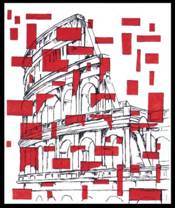 As I continued to explore the conceptual nature of the nervous system, I began to look at the network structure of the nervous system in which different areas connect to form the overall system and provide an interface with the external world through sensory input. This led to the idea of the painting as the window on the wor
As I continued to explore the conceptual nature of the nervous system, I began to look at the network structure of the nervous system in which different areas connect to form the overall system and provide an interface with the external world through sensory input. This led to the idea of the painting as the window on the wor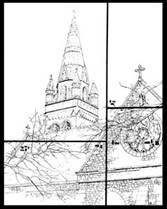 ld (e.g. Arnheim, 1974, pp 239). As such the painting can be a conceptual interface between inner experience and external reality. In order to make this idea explicit, I introduced various grid-like elements in the paintings to represent this interface as a structure between the internal and the external. Much of my earlier painting and drawing had been focused on interpretations of the landscape both natural and constructed. As a result I used this kind of subject matter for the “reality behind the interfaces.” I used a variety of sources including my impressions from a trip to Greece and Italy, local architectural subjects and landscapes. Images sizes are of the order of 12 to 20 inches and are watercolor and ink on paper. On the left is Coliseum Perceived and on the right is Packer Chapel.
ld (e.g. Arnheim, 1974, pp 239). As such the painting can be a conceptual interface between inner experience and external reality. In order to make this idea explicit, I introduced various grid-like elements in the paintings to represent this interface as a structure between the internal and the external. Much of my earlier painting and drawing had been focused on interpretations of the landscape both natural and constructed. As a result I used this kind of subject matter for the “reality behind the interfaces.” I used a variety of sources including my impressions from a trip to Greece and Italy, local architectural subjects and landscapes. Images sizes are of the order of 12 to 20 inches and are watercolor and ink on paper. On the left is Coliseum Perceived and on the right is Packer Chapel.
I continued making different variations on these ideas well into the 1980’s. Three of these are represented here.
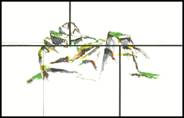

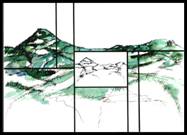
One of my larger paintings along these lines was a commission for an outdoor mural (4' high x 8' wide) based on perceptual/conceptual ideas about Bethlehem and its 18th century history. It was shown at in 1988 at Musikfest, A Citywide Arts Festival, in Bethlehem, PA. As this aspect of my continued to develop I began to replace the grid patterns with single words, phrases or free form poetry.
PART 2 INTERCTIVE ART
As I was working on these paintings I continued to think about other ways to involve characteristics of the nervous system. Neurons continually generate electrical activity of two general types, slow waves (the EEG is an example) and impulses (small voltage changes, each lasting a couple of milliseconds). As with any electrical activity this neural activity can be recorded, using a variety of sensors, amplified and fed into a speaker. Much of the slow wave activity is too low in frequency to be heard without modification. However, the impulses are heard as sequences of a sharp popping sound, which are fairly uniform in loudness but vary in tempo depending on the stimulation. Here I present a typical pattern of impulses as they would be recorded from one nerve cell over time (voltage on the y axis and time on the x axis). The black horizontal line is the baseline for measuring the voltage changes of the impulses.

The impulses are a primary way in which neurons communicate with each other, particularly as sensory systems respond to the external environment and convey that information into the central nervous system. Because they are a n integral part of the interface between our inner and outer worlds, I decided to incorporate the sounds of impulses into my paintings. To do this, I built small electronic pulse generators that produce patterns of impulses when turned on. I built picture frames that are deeper than usual for some of my paintings. In these deep frames I installed a generator with a speaker behind the painting. The generator is operated by a switch on the side of the frame. Viewers are free to turn on and off the switch as they see fit, and listen to the “patterns of impulses” as they view the painting. The medium for these paintings is oil on canvas. I show here an example, Parthenon Perceived. The brass plate on the bottom of the frame asks the viewer to “operate the switch on the right and listen while you look”. I showed a number of these works in a variety of group shows including, in 1978, in a Group Exhibition at the 112 Workshop, New York City, NY.
n integral part of the interface between our inner and outer worlds, I decided to incorporate the sounds of impulses into my paintings. To do this, I built small electronic pulse generators that produce patterns of impulses when turned on. I built picture frames that are deeper than usual for some of my paintings. In these deep frames I installed a generator with a speaker behind the painting. The generator is operated by a switch on the side of the frame. Viewers are free to turn on and off the switch as they see fit, and listen to the “patterns of impulses” as they view the painting. The medium for these paintings is oil on canvas. I show here an example, Parthenon Perceived. The brass plate on the bottom of the frame asks the viewer to “operate the switch on the right and listen while you look”. I showed a number of these works in a variety of group shows including, in 1978, in a Group Exhibition at the 112 Workshop, New York City, NY.
While this was interesting I was not quite satisfied because the viewer had to turn on a switch, which was not very natural. I needed some way to automatically generate the impulse patterns when viewers moved in from of the  paintings. Fortunately about this time in the late 1970’s, Apple had just released the Apple 2E microcomputer. With the Apple 2E, I build my first interactive sculpture/installation, Network, shown here. It is made of aluminum tubing stands about 7 feet tall, 20 feet long and 2 feet deep. There are small squares at all of the intersections of the tubing. Each of eight of these squares contains a small speaker. Inside each of the three front legs is a very sensitive light photocell. There are small holes in the legs through which light from the track lighting activates each photocell. When someone moves in front of a leg the shadow changes the amount of light reaching the photocell, and thus its electrical resistance. The photocells are wired to the microcomputer, which is monitoring the resistance of the photocells. When a change in resistance occurs the microcomputer generates a sequence of clicks (simulated nerve impulses) that are sent to a subset of the eight speakers at the intersections of the tubing. There is randomness in the program so that each time a photocell is activated a different pattern of impulses is sent to a different set of speakers. I did all the programming in Basic, but am indebted to David Rayna for designing and constructing the analogue to digital converters that I used.
paintings. Fortunately about this time in the late 1970’s, Apple had just released the Apple 2E microcomputer. With the Apple 2E, I build my first interactive sculpture/installation, Network, shown here. It is made of aluminum tubing stands about 7 feet tall, 20 feet long and 2 feet deep. There are small squares at all of the intersections of the tubing. Each of eight of these squares contains a small speaker. Inside each of the three front legs is a very sensitive light photocell. There are small holes in the legs through which light from the track lighting activates each photocell. When someone moves in front of a leg the shadow changes the amount of light reaching the photocell, and thus its electrical resistance. The photocells are wired to the microcomputer, which is monitoring the resistance of the photocells. When a change in resistance occurs the microcomputer generates a sequence of clicks (simulated nerve impulses) that are sent to a subset of the eight speakers at the intersections of the tubing. There is randomness in the program so that each time a photocell is activated a different pattern of impulses is sent to a different set of speakers. I did all the programming in Basic, but am indebted to David Rayna for designing and constructing the analogue to digital converters that I used.
It was first shown at the Computer Arts Festival at Lehigh University, Bethlehem, PA in 1982. The Lehigh exhibit  subsequently traveled to the Hansen Gallery in New York City for an exhibit retitled, Art by Computer and Video in 1982. For that exhibit I modified Network and created Disembodied Network, shown here to the left. I eliminated all of the tubing and mounted the squares with the speakers on a gallery wall. The photocells were housed in small tubes against the wall at the floor level. All of the electronics were out of sight behind the wall, as shown here. It operated with the same computer program as Network.
subsequently traveled to the Hansen Gallery in New York City for an exhibit retitled, Art by Computer and Video in 1982. For that exhibit I modified Network and created Disembodied Network, shown here to the left. I eliminated all of the tubing and mounted the squares with the speakers on a gallery wall. The photocells were housed in small tubes against the wall at the floor level. All of the electronics were out of sight behind the wall, as shown here. It operated with the same computer program as Network.
From this point on, my Neural Art work took a number of different directions. Expanding on the ideas and technology involved in Network, I created a number of individual interactive sculptures that generated sound patterns simulating nerve impulses. Using the Apple 2E I also created several sculptures in which viewer movements changed the monitor display. These were shown in a number of one-man and group exhibits including Ars Electronica in Linz, Austria.
I also began to do some site specific works still using the interactive sounds simulating neural impulses. For example, I transformed a large tree into an interactive sound sculpture at the Mayfair Festival in Allentown, PA. Similarly, the Frank Lloyd Wright Library at the Allentown Art Museum was transformed.
This was also the period during which I started to create books, based on the neurophysiological ideas. Please see the book section for details.
In addition, during the 1980’s and early 90’s I published articles and presented my ideas and descriptions of my works at a variety conferences. I have listed the references to the articles and proceedings of the conferences below.
As the technology advanced, I incorporated samplers which allowed me to use musical notes and voices in my sound interactive sculptures and installations. In all cases, I resisted the temptation to use the technology for making spectacular effects just for their own sake. I wanted focused, thought producing work. Most notably among the installations with Neural Art ideas are Doorways of Meaning, Voices in the Edges and An Interactive Garden, all described in Installations One man Exhibitions, on the website. The sculptures with my Neural Art ideas are Sheltering Hut and Seeing the Landscape from within, both described on the website in Interactive Sculptures. Seeing the Landscape from within is the most recent, having been completed in 2014. These sculptures have been possible by using miniturized processors to reduce space. While these are fairly explicit Neural Art works, all of my other works have the Neural Art approach in the background of my thinking, and are various ways to engage other nervous systems. This continues to be true as I develop my new works.
References
Arnheim, R. (1974). Art and Visual Perception. University of California Press, Berkeley, CA
Shortess, G. K. (1974). Some physiological limitations on aesthetic experience in the visual arts. Leonardo, 7, 57-59.
Shortess, G. K. (1982). An application of a microcomputer as an interactive art medium. Proceedings of the Second Symposium on Small Computers in the Arts. IEEE Computer Society Catalog No. 455, 75-77.
Shortess, G. K. (1983). Neural art: Works based on concepts of the nervous system. Leonardo, 16, 306-309.
Shortess, G. K. (1983). A computer controlled installation in a gallery space. Proceedings of the Third Symposium on Small Computers in the Arts, IEEE Computer Society Catalog No. 499, 81-85.
Shortess, G. K. (1984). Red network: A conceptual art piece using microcomputers. Proceedings of the Fourth Symposium on Small Computers in the Arts, IEEE Computer Society Catalog 610, 72-75.
Shortess, G. K. (1985) Art, microcomputers and the Mona Lisa. Proceedings of the Fifth Symposium on Small Computers in the Arts, IEEE Computer Society Catalog No. 689, 13-17.
Shortess, G. K. (1986) NEURAL; An artist's book. Proceedings of the Sixth Symposium on Small Computers in the Arts, IEEE Computer Society Catalog No. 755, 63-66.
Shortess, G. K. (1987). Interactive sound installations using microcomputers. Leonardo, 20, 149-153.
Shortess, G. K. (1988) Computer-based art and experimental aesthetics. Paper presented at the Xth International Colloquium on Empirical Aesthetics, Barcelona/Sicily, Italy, sponsored by the I.A.E.A
Shortess, G. K. (1989) Sound and imagery in the arts. Invited paper, the 12th International Congress on Cybernetics, Namur, Belgium, sponsored by the International Association for Cybernetics.
Shortess, G. K. (1989) Symmetry in interactive art. Invited paper, the Interdisciplinary Symmetry Symposium, Symmetry of Structure, Budapest, Hungary, sponsored by UNESCO, International Union of Crystallography, and IEEE.
Shortess, G. K. (1989). Inhalt und Verfahren: Einige Uberlegungen. (Content and Process: Some Reflections). Kunstforum, Bd.103, 180-187.
Shortess, G. K. (1990) Sketching a Psychological Framework for Interactive Art. Paper presented at the XIth International Congress on Empirical Aesthetics, Budapest, Hungary, sponsored by I.A.E.A.
Shortess, G. K. (1991). Mental models for interactive art. Art and Emotions. Proceeding of the International Symposium, Perm (USSR) State Institute of Culture, 153-159.
Shortess, G. K. (1996). Perception as action. Artists Using Science and Technology Newsletter, 11-12.